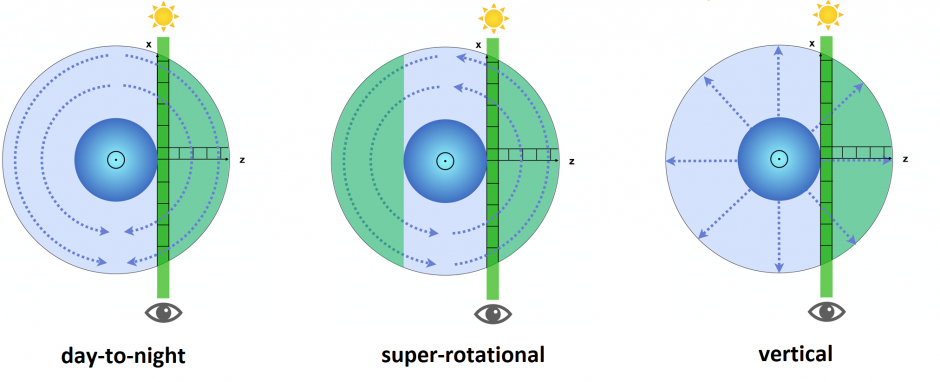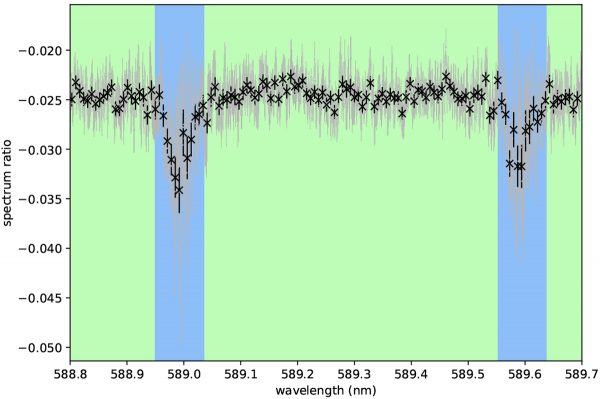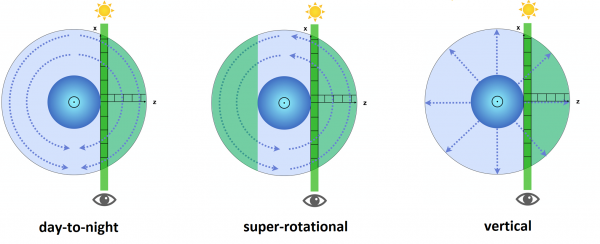Otherworldly winds

A group of scientists led by the NCCR-PlanetS and the University of Geneva, investigated wind patterns of an exoplanet with extreme conditions. Their insights may also help us understand the atmospheres of other worlds. Including our own.
Imagine you were looking down upon the Earth from space. Your task would be to discern the general patterns of motion in its atmosphere.
To make things worse, you would be light-years away and have little more information available than the difference in the observed sunlight, when Earth passed by in front of the Sun.
This gives you an idea of the situation exoplanet researchers find themselves in.
A hot Jupiter with sodium
Researchers like Julia Seidel of the NCCR PlanetS and her colleagues. The team set out to learn about wind patterns of an exoplanet by the name of HD189733b, some 64 light-years away. It is a gaseous planet, not unlike Jupiter, that resides in close proximity to its star. So close, that if you were to look at the sky from its surface, the star would make up something like a quarter of what you would see.
Naturally, the planet is very hot. Its mean temperature is over 3000 degrees Celsius. “All this heat puffs up the entire atmosphere”, as Seidel explains. “Everything is evaporated and the atmosphere extends far beyond what you’d expect.”
To get a better idea of the physical mechanisms behind this “puffed up” atmosphere, the scientists used the “HARPS” spectrograph at the European Southern Observatory’s 3.6-meter telescope in La Silla, Chile. With it, they measured changes in the light caused by the planet passing by between the instrument and the star. A so-called transit.
Some of these changes are due to the gases in the planet’s atmosphere, which absorb light. Among them, sodium-gases, which absorb quite strongly in the yellow spectrum, with a distinctive pattern – the so called “sodium doublet”. The pattern measured by the scientists is shown below.

The transmission spectrum of HD189733b for the sodium doublet as measured by Seidel et al., 2020.
“The reason we looked at sodium, is that it is detectable over a large part of the atmosphere and thus gives us a good overview”, Seidel tells PlanetS. “The lower parts of the sodium absorption peaks, corresponding to layers of the atmosphere below the thermosphere, show significant broadening”, she explains. “More than what you would expect, even accounting for pressure and temperature broadening”.
A feature that pointed towards strong winds inducing the so-called “Doppler broadening” of a peak.
What we call pitch, is related to the frequency of the sound waves. When the frequency increases, i.e. when more waves reach us per time, the pitch increases. In the case of the ambulance, this is caused by its movement towards us.
The same effect can be observed for other kinds of waves. Sources of light, for example, appear more red when moving away from us. This is because the frequency decreases. In Astronomy, this effect – the so called Redshift – has long been used to determine that the universe expands.
When light emitted from its star travels through the atmosphere of HD 189733b, parts of it interact with sodium. The sodium-molecules, however, are moved around by strong winds. From our point of view, some towards us, some away from us. Their re-emitted light is thus shifted in its spectrum, which is then measured as the broadening.
Therefore, the outwards extension of the atmosphere seemed to originate from winds below the thermosphere.
But what kind of winds could generate the broadening that the measurements revealed?
Extreme is simpler…
On Earth wind patterns are quite complex. In mid latitudes, winds predominantly blow from the West. Further towards the poles and the Equator, from the East. The patterns shift to the North and the South with the seasons and can change with altitude.
On HD189733b, things are simpler. Due to the extreme heat and other parameters such as planetary gravity, only three large scale patterns (and combinations thereof) were likely:
- Winds blowing from the day side of the planet to the night side (due to the planet’s proximity to its star, it is “tidally locked” to it. I.e. the same side always faces the star – similar to the Moon and Earth.).
- Winds, that blow along the rotational axis, quicker than the rotational speed of the planet (so called “super-rotational winds”).
- Upwards blowing vertical winds.
These patterns were then generated with relatively simple models of the atmosphere, that made economical use of available computational power. Still, they contained an upper layer and a lower layer that combined different wind patterns. For example, the lower layer could exhibit day-to-night wind and vertical winds would occur in the upper layer.

Plausible wind patterns of HD189733b, as computed by Seidel et al., 2020.
On the basis of these modelled atmospheres, the scientists created artificial transmission spectra for sodium (similar to the one shown above) that could be compared to the actual measurements. This comparison provided information about which patterns and variations thereof could reproduce the observations best and thus be the most likely.
The results are inconclusive for the lower layer, below the thermosphere. But they indicate that the upper layer is dominated by vertical winds. And extreme ones at that: the best estimate clocks at several times the speed of sound. These extremely high velocities may be influenced by a strong magnetic field in the planet’s equatorial region.
…but questions remain

Seidel et al. thus propose a possible answer to the question of the “puffed up” atmosphere on HD189733b and the associated Doppler broadening: extreme vertical winds in the upper atmospheric layers.
But as so often in science, that answer does not come without new questions. For example, regarding what goes on closer to the surface. “Current data quality does not allow us to distinguish wind patterns in the lower atmosphere”, the group writes in their publication.
Further research with new generations of instruments, as for example the ESPRESSO spectrograph at ESO’s Paranal Observatory in Chile, will allow them to improve their understanding. Understanding, that may not only be relevant for hot Jupiters.
“Ultimately”, Julia Seidel says, “understanding these extreme worlds helps us to appreciate the delicate balance that enables us to inhabit Earth. The difference of conditions that allow a life with Gin Tonics to such that lead to a hellish inferno is not that large”.
Reference: V. Seidel, D. Ehrenreich, L. Pino, V. Bourrier, B. Lavie, R. Allart, A. Wyttenbachand C. Lovis, Wind of change: retrieving exoplanet atmospheric winds from high-resolution spectroscopy, DOI https://doi.org/10.1051/0004-6361/201936892, Published in Astronomy & Astrophysics, 17 January 2020

